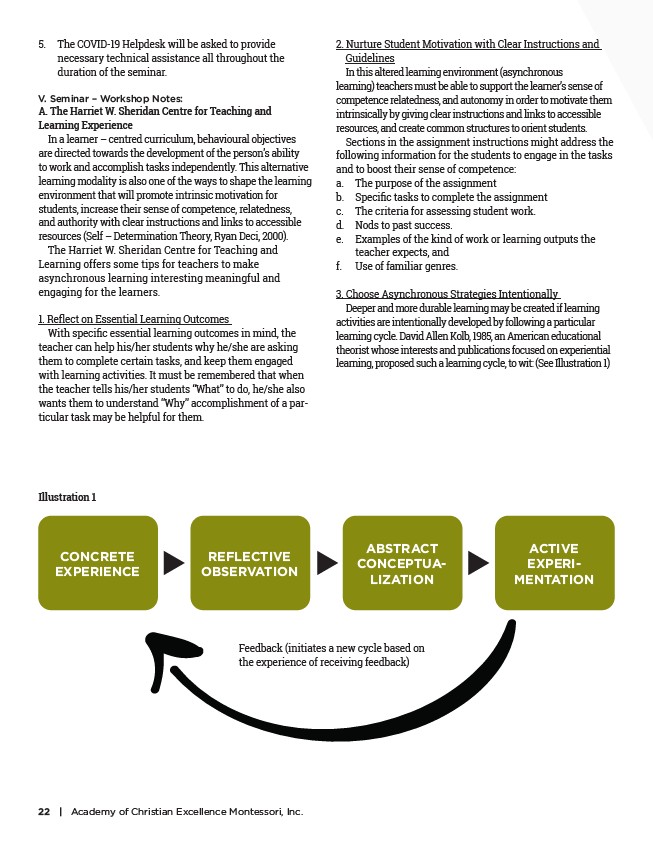
5. The COVID-19 Helpdesk will be asked to provide
necessary technical assistance all throughout the
duration of the seminar.
V. Seminar – Workshop Notes:
A. The Harriet W. Sheridan Centre for Teaching and
Learning Experience
In a learner – centred curriculum, behavioural objectives
are directed towards the development of the person’s ability
to work and accomplish tasks independently. This alternative
learning modality is also one of the ways to shape the learning
environment that will promote intrinsic motivation for
students, increase their sense of competence, relatedness,
and authority with clear instructions and links to accessible
resources (Self – Determination Theory, Ryan Deci, 2000).
The Harriet W. Sheridan Centre for Teaching and
Learning offers some tips for teachers to make
asynchronous learning interesting meaningful and
engaging for the learners.
1. Reflect on Essential Learning Outcomes
With specific essential learning outcomes in mind, the
teacher can help his/her students why he/she are asking
them to complete certain tasks, and keep them engaged
with learning activities. It must be remembered that when
the teacher tells his/her students “What” to do, he/she also
wants them to understand “Why” accomplishment of a particular
task may be helpful for them.
2. Nurture Student Motivation with Clear Instructions and
Guidelines
In this altered learning environment (asynchronous
learning) teachers must be able to support the learner’s sense of
competence relatedness, and autonomy in order to motivate them
intrinsically by giving clear instructions and links to accessible
resources, and create common structures to orient students.
Sections in the assignment instructions might address the
following information for the students to engage in the tasks
and to boost their sense of competence:
a. The purpose of the assignment
b. Specific tasks to complete the assignment
c. The criteria for assessing student work.
d. Nods to past success.
e. Examples of the kind of work or learning outputs the
teacher expects, and
f. Use of familiar genres.
3. Choose Asynchronous Strategies Intentionally
Deeper and more durable learning may be created if learning
activities are intentionally developed by following a particular
learning cycle. David Allen Kolb, 1985, an American educational
theorist whose interests and publications focused on experiential
learning, proposed such a learning cycle, to wit: (See Illustration 1)
CONCRETE
EXPERIENCE
REFLECTIVE
OBSERVATION
ABSTRACT
CONCEPTUALIZATION
ACTIVE
EXPERIMENTATION
Illustration 1
Feedback (initiates a new cycle based on
the experience of receiving feedback)
22 | Academy of Christian Excellence Montessori, Inc.